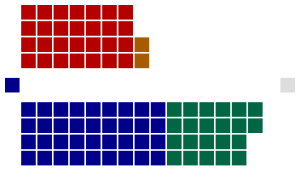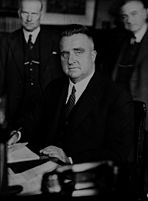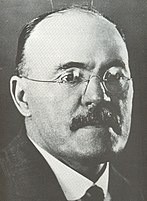1938 New South Wales state election
| ||||||||||||||||||||||||||||||||||
All 90 seats in the New South Wales Legislative Assembly 46 Assembly seats were needed for a majority | ||||||||||||||||||||||||||||||||||
|---|---|---|---|---|---|---|---|---|---|---|---|---|---|---|---|---|---|---|---|---|---|---|---|---|---|---|---|---|---|---|---|---|---|---|
| ||||||||||||||||||||||||||||||||||
 Legislative Assembly after the election | ||||||||||||||||||||||||||||||||||
| ||||||||||||||||||||||||||||||||||
The 1938 New South Wales state election was held on 26 March 1938. This election was for all of the 90 seats in the 32nd New South Wales Legislative Assembly and was conducted in single member constituencies with compulsory preferential voting.
The result of the election was:
- United Australia Party 37 seats
- Country Party 22 seats
- Australian Labor Party 28 seats
- Industrial Labor Party 2 seats
- Independent 1 seat.
The UAP/Country Party coalition of Bertram Stevens/Michael Bruxner had a majority of 28 (down 2). Stevens continued as Premier until 5 August 1939 when he was deposed by his party and replaced by Alexander Mair.
Labor's continued poor showing in this election was seen as evidence of Jack Lang's inability to appeal to the middle ground of the electorate. As a result, moves to dispose Lang intensified. The Industrial Labor Party led by Lang rival Bob Heffron was re-absorbed into the ALP on 26 August 1939 and Lang was replaced as party leader by William McKell on 5 September 1939.
During this parliament the ALP and Industrial Labor each won 2 by-elections from the UAP. This reduced the Government's majority to 20 when the parliament was dissolved.
Key dates
| Date | Event |
|---|---|
| 24 February 1938 | The Legislative Assembly was dissolved, and writs were issued by the Governor to proceed with an election. |
| 4 March 1938 | Nominations for candidates for the election closed at noon. |
| 26 March 1938 | Polling day. |
| 26 April 1938 | The writs were returned and the results formally declared. |
| 12 April 1938 | Opening of 32nd Parliament. |
Results
|
New South Wales state election, 26 March 1938 | ||||||
|---|---|---|---|---|---|---|
| Enrolled voters | 1,607,833[1] | |||||
| Votes cast | 1,183,257 | Turnout | 95.79 | –0.27 | ||
| Informal votes | 32,237 | Informal | 2.65 | –0.39 | ||
| Summary of votes by party | ||||||
| Party | Primary votes | % | Swing | Seats | Change | |
| United Australia | 424,275 | 35.86 | +2.76 | 37 | – 1 | |
| Labor | 412,063 | 34.82 | –7.60 | 28 | –1 | |
| Country | 164,045 | 13.86 | +0.94 | 22 | –1 | |
| Industrial Labor | 43,735 | 3.70 | +3.70 | 2 | +2 | |
| Communist | 10,386 | 0.88 | –0.6 | 0 | ±0 | |
| Independents | 128,753 | 10.88 | +6.4 | 1 | +1 | |
| Total | 1,183,257 | 90 | ||||
- 1 A total of 19 electorates (six UAP, three Country, and ten Labor) were uncontested, representing 338,853 voters.[1]
References
- ^ 1938 Election Totals - Overall Election Results – NSW Elections. Retrieved 4 July 2014.
Sources
- "Former members of the New South Wales Parliament, 1856-2006". New South Wales Parliament. Retrieved 11 January 2009.
- Antony Green. "NSW Elections Analysis". New South Wales Parliament. Retrieved 12 January 2009.
- Nairn, Bede (1995)Jack Lang the 'Big Fella':Jack Lang and the Australian Labor Party 1891-1949
Melbourne University Press Melbourne ISBN 0-522-84700-5 OCLC 34416531


